With the current speed of our discoveries, it might seem like we’ll soon run out of mysteries to unravel, putting all the bothersome scientists out of their jobs. That’s just a jest, though. The fascinating minds of ancient civilizations have left us plenty of tasks to tackle, at times trivial yet perpetually intriguing.
Throughout history, the world’s ancient civilizations were advanced and profoundly civilized. Some are well-known and exhaustively researched, like the Egyptians, while others, such as the Garamantes, remain hidden in obscurity. Today, we’ve gone above and beyond and found you the facts that will force us to look at our ancient forefathers through new eyes.
Yes, friends, we are dispelling myths, updating inaccurate information, and eliciting more admiration and respect.
Here are 25 Unbelievable Facts About Ancient Civilizations.

The Mayans Enjoyed Flavoured Tobacco
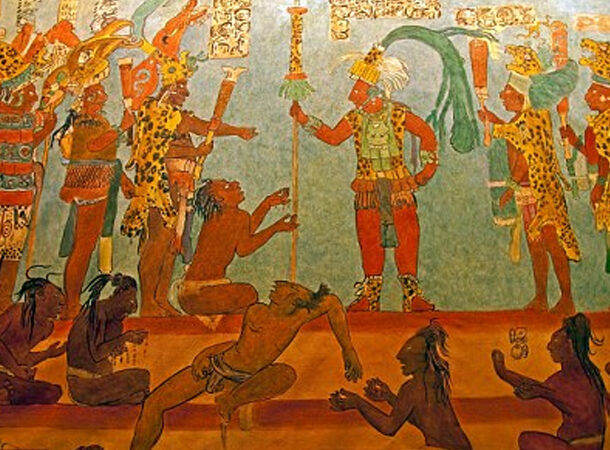 https://www.sciencedaily.com/releases/2021/01/210115110339.htm
https://www.sciencedaily.com/releases/2021/01/210115110339.htm Marigold will not get you high. Nonetheless, it appears that the ancient Maya smoked the plant. Washington State University discovered this smokey fact after testing 14 clay pots used by the Maya as tobacco containers over 1,000 years ago.
The discovery is especially noteworthy because the marigold is the first non-tobacco plant discovered inside these vessels. In fact, the plant shared the ancient containers with two different types of tobacco. For the moment, nobody knows why the Maya stuffed their pots with marigolds. However, they were most likely used as a flavor enhancer to improve the flavor of the tobacco – and that tells us a lot about the Maya’s discerning taste buds.
The Wari Empire’s Elite Female Brewers
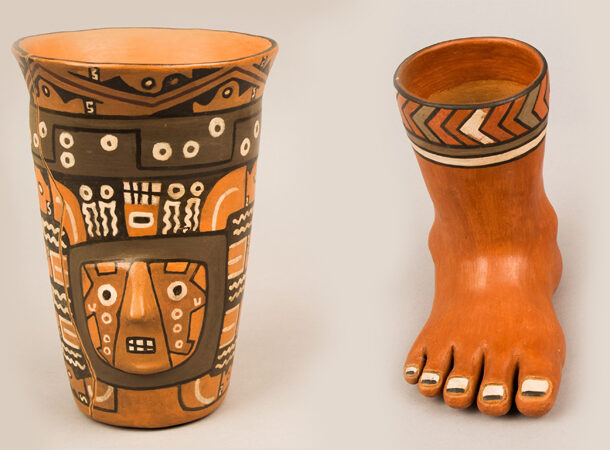 http://www.livescience.com/485-elite-women-beer-pre-incan-culture.html
http://www.livescience.com/485-elite-women-beer-pre-incan-culture.html The Wari, an ancient civilization that predate the Incas, thrived for hundreds of years in Peru’s Andes Mountains before their civilization collapsed. This item made it to our list because a study conducted in 2005 by experts from the University of Florida and the Field Museum found that the Wari Empire’s brewers were women.
And not just “women”. The researchers discovered that the female beer makers were neither slaves nor low-status women but were instead born from the elite and prized for their beauty. This discovery illustrates that women performed a more essential role in ancient Andean societies than our textbooks have suggested. And not just because they provided the best alcoholic beverages. The beer made by the most talented female brewers 1,000 years ago was known as chicha. It was created from Peruvian peppertree berries and corn.
Civilizations in Ancient Times Were More Connected Than We Think
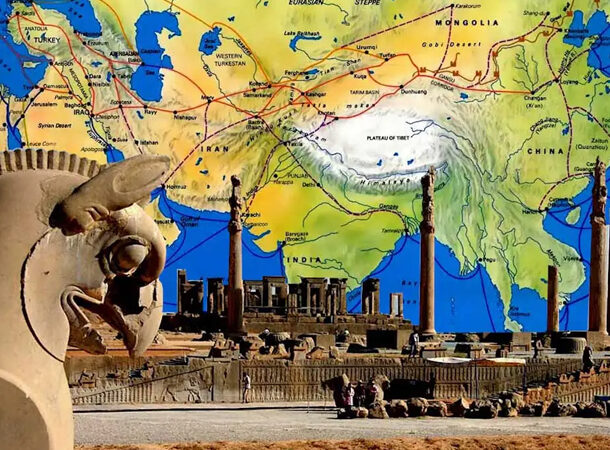 https://www.cambridge.org/core/journals/greece-and-rome/article/abs/greek-culture-in-afghanistan-and-india-old-evidence-and-new-discoveries/B3F52FAB547670C9C6FE9F49BA1CFD66
https://www.cambridge.org/core/journals/greece-and-rome/article/abs/greek-culture-in-afghanistan-and-india-old-evidence-and-new-discoveries/B3F52FAB547670C9C6FE9F49BA1CFD66 It’s fascinating to know that in ancient times, people from diverse regions of the world embarked on extensive journeys in search of novel experiences. For example, Romans voyaged to China, Greeks explored India, and Africans traveled to England. Although the Silk Road is often acknowledged, the truth is that ancient civilizations had an even broader reach than we may realize.
There were, for example, Phoenician explorers who likely traveled around Africa two millennia before Vasco de Gama. Carthaginians explored as far north as Greenland and as far south as Sierra Leone, spreading Mediterranean culture throughout Africa. Thanks to Alexander the Great, Hellenistic civilization made its way to what is now Pakistan, India, and Afghanistan. And the Romans! They attracted warriors across the empire, including Mauritania, a country known for its horsemen. There is even evidence of Roman trading outposts in Kerala, India, dating back to the first century BCE. Take that, Marco Polo!
The Sanxingdui (sahn-shing-dway) Civilization Was Ended By An Earthquake
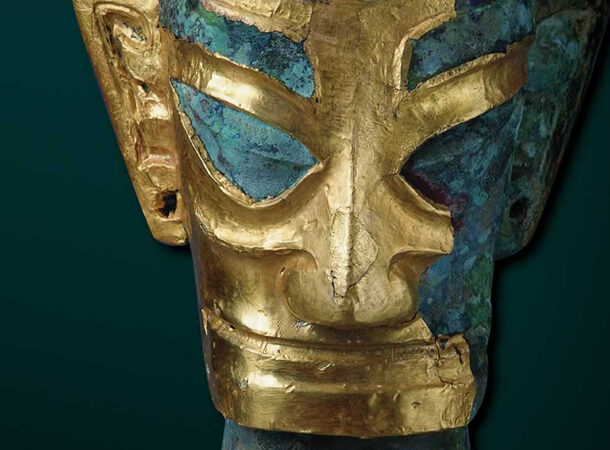 http://www.livescience.com/49247-chinese-civilization-disappearance-explained.html
http://www.livescience.com/49247-chinese-civilization-disappearance-explained.html Sanxingdui was an ancient Chinese civilization and settlement that flourished in China’s Sichuan Province. The advanced civilization was lost for thousands of years until its rediscovery in 1929 when a peasant uncovered jade and stone artifacts while mending a sewage canal. War and floods are the two most popular theories surrounding Sanxingdui’s strange disappearance. However, in 2014, Niannian Fan of Tsinghua University in Chengdu, China, released research revealing how an earthquake wiped out the Sanxingdui civilization.
According to Fan’s research, a major earthquake around 3,000 years ago created devastating landslides that redirected the course of Sanxingdui’s river. The residents merely relocated to be closer to the altered river flow. Historical data of earthquakes near Sanxingdui confirm this viewpoint.
The Fall of Rome Didn't End The Empire
 http://www.edwardgoldsmith.org/28/the-fall-of-the-roman-empire/?show=all
http://www.edwardgoldsmith.org/28/the-fall-of-the-roman-empire/?show=all We are taught that Roman domination ended in 476 CE when the city fell to German barbarians known as the Vandals. However, Rome’s (re)sacking was a mere blip on the Mediterranean radar. By the time of its “fall,” Rome’s importance had been surpassed in the west by Ravenna, the capital of the Western Empire. Another reason Rome’s fall was not as disastrous as believed came in the form of the Gothic general Odoacer, who toppled the last Western Roman Emperor. He didn’t want to change anything; he just wanted to be in command. Odoacer ensured that the legitimate emperor in Constantinople was recognized and that the status quo was maintained.
So, for the common Roman, life went on as usual for decades after the last emperor fell. That’s because the “barbarians” who took over – Ostrogoths, Goths, and Germans – had been a long-standing part of the Roman Empire as client-states, a growing group within the Roman military, and quasi-citizens. When a barbarian-Roman coalition eventually destroyed the Huns in 451 CE, it was nearly impossible to figure out where the Romans ended and the barbarians started. In the end, the Roman Empire came to its demise not by a foreign invasion but by a succession of civil wars that devastated the frontier.
The “Barbarians” Were Nothing More Than People Who Didn’t Speak Greek
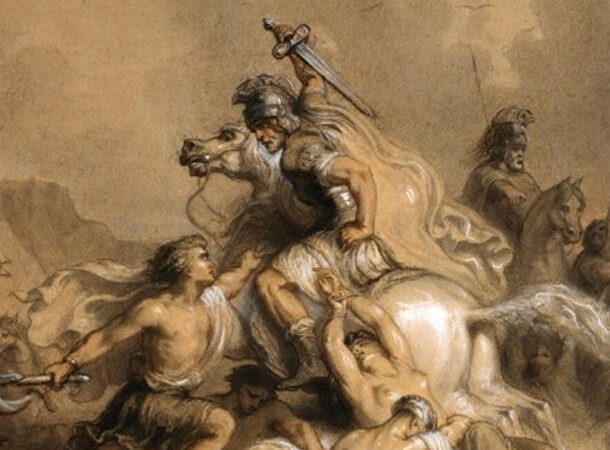 https://books.google.com/books?id=L6xBsaLlFyYC&pg=PA149&dq=ancient+barbarians+babble&hl=en&sa=X&ei=4eAlU74Q5ubJAZ-ogIAG&ved=0CCoQ6AEwAA#v=onepage&q=ancient%20barbarians%20babble&f=false
https://books.google.com/books?id=L6xBsaLlFyYC&pg=PA149&dq=ancient+barbarians+babble&hl=en&sa=X&ei=4eAlU74Q5ubJAZ-ogIAG&ved=0CCoQ6AEwAA#v=onepage&q=ancient%20barbarians%20babble&f=false Since we’re discussing the end of the Rioman Empire, did you know that “barbarians” were just people who couldn’t speak Greek to the ancient Greeks? You see, the ancient Greeks thought foreigners’ speech sounded like babbling (bar-bar-bar); as such, they named them “barbaroi.”
The Greeks were not so arrogant as to dismiss the achievements of other civilizations such as Egypt, Persia, etc. Even though their societies were regarded as magnificent, their non-Greek-speaking residents would still have been labeled “barbarians.”The term “barbarian” was employed by the ancient Romans in the same way that it was used by the Greeks. Barbarians were people who did not live within the Roman Empire and could not speak Latin. Only as antiquity gave way to the Middle Ages did the term “barbarian” take on its now-famous derogatory meaning of barbarism.
The Minoans Were Fierce Warriors
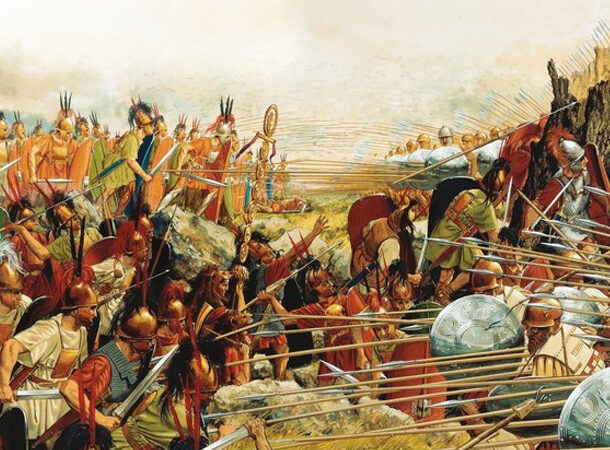 https://www.sheffield.ac.uk/news/nr/war-central-minoans-ancient-crete-1.235205
https://www.sheffield.ac.uk/news/nr/war-central-minoans-ancient-crete-1.235205 The Minoan Civilization flourished around 3000 BCE and lasted for 2000 years until they vanished in 1100 BCE. Yes, the civilization lasted for 2,000 years. Let that sink in for just a second. They had a couple of hundred years on most of us. Minoans have been hailed as a fantastic example of an ancient society that avoided combat and violence at all costs since their re-discovery over a century ago. However, despite popular opinion, the Minoan Civilization was not peaceful.
Minoan culture was, in fact, dependent upon warfare. New research published by archaeologists from the University of Sheffield also demonstrated that Minoan male identity was intrinsically linked to the culture’s warrior identity and that most of the weaponry used throughout Europe during the Middle Ages, such as spears and swords, originated from the Minoans.
The Carthaginians Practiced Child Sacrifice
 http://www.ox.ac.uk/news/2014-01-23-ancient-carthaginians-really-did-sacrifice-their-children
http://www.ox.ac.uk/news/2014-01-23-ancient-carthaginians-really-did-sacrifice-their-children Scholars have argued whether the people of ancient Carthage, which lasted from 800 BCE to 146 BCE, practiced child sacrifice for decades. During the twentieth century, scholars from Italy and Tunisia spread a rumor that the ancient Carthaginians did not partake in this heinous practice. The Greeks and Romans, they claimed, were behind this “racist anti-Carthaginian propaganda.” They further argued that the tophets, or ancient burial grounds where the remains of children were discovered, were merely child cemeteries.
However, coordinated research conducted by experts from numerous universities throughout the world, such as Oxford University, contradicts this view. According to the study, a staggering quantity of literary, historical, documentary, epigraphic, and archaeological evidence suggests that Carthaginian parents sacrificed their children to the gods.
Republican Governments Were Not Invented In Rome Alone
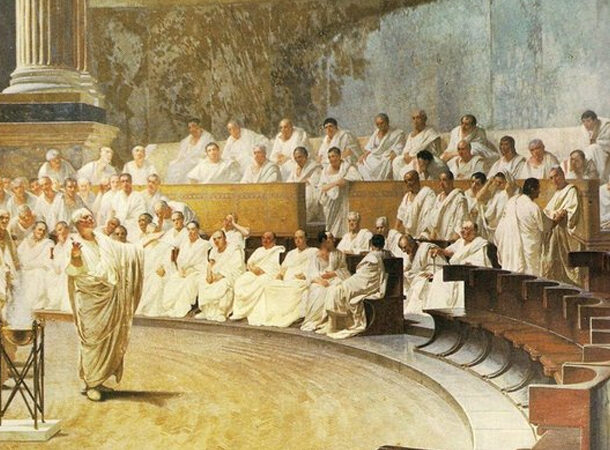 https://books.google.com/books?id=Nqm-Vp90E5UC&pg=PA236&dq=ancient+indian+republics&hl=en&sa=X&ei=ApAkU_HhMIGhqwH45YHICA&ved=0CDIQ6AEwADgK#v=onepage&q=ancient%20indian%20republics&f=false
https://books.google.com/books?id=Nqm-Vp90E5UC&pg=PA236&dq=ancient+indian+republics&hl=en&sa=X&ei=ApAkU_HhMIGhqwH45YHICA&ved=0CDIQ6AEwADgK#v=onepage&q=ancient%20indian%20republics&f=false Greece? Democracy. Rome? Republic. India? To be fair, most of us weren’t taught anything about ancient India’s governmental structures. While ancient India did have its share of despots, it also had several minor republics.
Around the same time Rome’s famed republic was created, some cities and towns in India embraced republican concepts such as representation and collaborative decision-making. However, as far as we know, the republican ideals of India and Rome evolved independently. The first records of republican-style administration in India come from approximately 600 and 480 BCE. Despite their small size, several Indian republics survived contact with Alexander the Great, as well as the subsequent conquering efforts by the legendary Guptas.
“Gun Control” Isn’t A New Concept
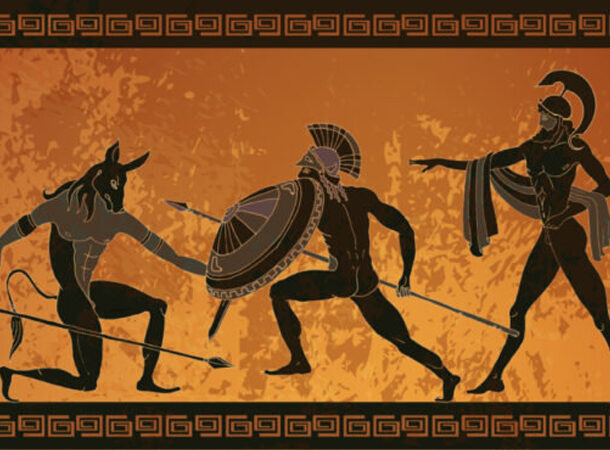 http://www.newyorker.com/online/blogs/culture/2013/02/how-the-greeks-viewed-weapons.html
http://www.newyorker.com/online/blogs/culture/2013/02/how-the-greeks-viewed-weapons.html It may be difficult to believe if you’ve seen the 2014 sequel to the film 300, but Greek cities practiced a stringent form of weapon control. Despite the ordinarily bellicose spirit of Greek society, weapons were forbidden in the ancient poleis’ public spaces. In fact, carrying weapons in a public area or market was viewed as a type of aggressive revolt.
You may wonder just how serious the Greeks felt about “sword control”? Charondas, the Greek-Sicilian senator who forbade “revealed and carry,” returned from the fields to the public assembly one day and forgot to remove his dagger. Granted, he’d just been fighting robbers in the countryside, but Charondas’ law was as firm as his dedication to it. Charondas, having broken his own law, committed suicide in public with the dagger he had failed to lay aside. It might sound a bit drastic, but the ancient Greeks believed that Laws alone rule. When weapons rule, the law is killed.
Plastic Surgery in Ancient India
 https://books.google.com/books?id=cx9alhd08mUC&pg=PA126&dq=ancient+greeks+surgery+noses&hl=en&sa=X&ei=X5obU_6zLOqGyAGCwoGIDw&ved=0CEAQ6AEwAQ#v=onepage&q=ancient%20greeks%20surgery%20noses&f=false
https://books.google.com/books?id=cx9alhd08mUC&pg=PA126&dq=ancient+greeks+surgery+noses&hl=en&sa=X&ei=X5obU_6zLOqGyAGCwoGIDw&ved=0CEAQ6AEwAQ#v=onepage&q=ancient%20greeks%20surgery%20noses&f=false In contrast to the ancient Greeks and Romans, the ancient Indian warriors did not wear protective helmets. Because of the brutality of warfare, noses, ears, and other body parts were frequently severed. To deal with these traumas, Hindu doctors developed treatments that would not be out of place when it comes to today’s modern surgery procedures. With many Indians losing their noses due to wars and harsh punishments for minor offenses, Indian surgeons became skilled at conducting rhinoplasty procedures.
To build the new nose, Indian surgeons removed a flap of skin from the patient’s forehead and draped it over the nasal openings. During the healing process, hollow tubes were inserted to form the nostrils. The first successful operations were documented around 500 BCE.
Coded Writing Was Used Differently In The Past
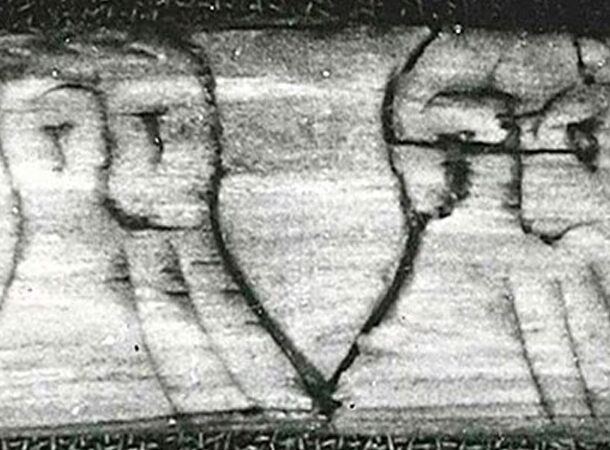 http://sciencenordic.com/mysterious-code-viking-runes-cracked
http://sciencenordic.com/mysterious-code-viking-runes-cracked Coded writing was once employed for entertainment instead of secrecy. Some people even created a game out of it, making runes that boastfully dared others to “interpret me if you can.” This was particularly tough for the Jotunvillur code, which, by its nature, renders messages completely ambiguous. The desired characters (runes) are switched for the last sound in their name. For instance, maor (or “m”) becomes “r.”
Crypto-anthropologists recently deciphered a Viking code from the late Middle Ages that had remained a mystery for many years. This was made possible by a small Rosetta Stone, a modest engraving on which two people wrote their names in both coded and basic runic. Researchers were salivating at the idea of decoding the painstakingly guarded secret or, at the very least, some scandalous gossip when they came across an 800-year-old joke instead. The message simply read, “Kiss me.” Overall, the Jotunvillur code offers nothing important, only a fascinating glimpse at some unexpectedly humorous Viking shenanigans.
The Neo-Assyrians Used Weird “Coins”
 http://www.cam.ac.uk/research/news/prehistoric-book-keeping-continued-long-after-invention-of-writing
http://www.cam.ac.uk/research/news/prehistoric-book-keeping-continued-long-after-invention-of-writing In Ziyaret Tepe, Turkey, anthropologists discovered an old global oddity when they unearthed a horde of oddly shaped coins at an excavation site. The clay coins, which ranged in shape from pyramids to wizards’ hats, functioned as tokens of commerce that took place in the ancient city of Tushan.
The tokens were standard before the arrival of written writing and were cleverly employed in an empire-wide administration system to catalog the Neo-Assyrian nation’s many products and resources. They vanished from history around 3000 BCE. However, the recently discovered stockpile in Turkey dates back to roughly 1000 BCE, when cuneiform writing was in full swing. Despite the coins’ apparent obsolescence, it’s clear that people still exchanged them rather than simply recording transactions textually.
Climate Change Caused The Collapse Of The Harappan Civilization
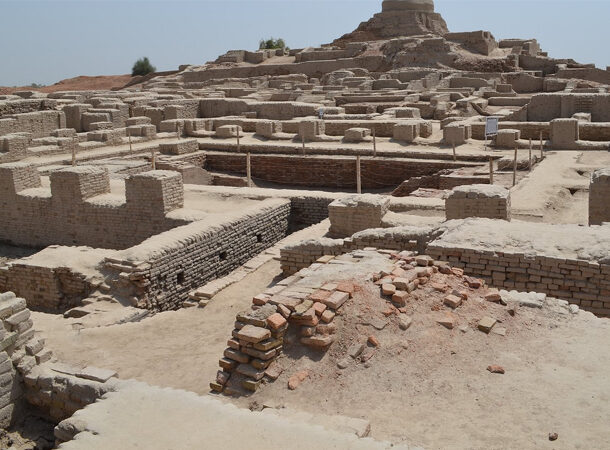 http://www.livescience.com/20614-collapse-mythical-river-civilization.html
http://www.livescience.com/20614-collapse-mythical-river-civilization.html It’s incredible that the Harappan civilization, which surpassed ancient Egypt and Mesopotamia when it comes to size, population, democracy, and advancement, is the least well-known of the world’s first great civilizations. At its peak, the civilization covered about 1 million square kilometers or 390 thousand square miles, encompassing modern-day India, Bangladesh, Nepal, and Pakistan. Unfortunately, this amazing society fell roughly 4,000 years ago, and the cause remained undiscovered until recently.
A team of experts recreated the landscape of the waterways and plains where the Harappan civilization prospered and discovered that ancient climate change caused the monsoon-fed rivers that sustained their agricultural activities to dry up. This resulted in the demise of major towns and the exodus of its residents to the East, particularly the Ganges valley, where they could rely on more reliable monsoon rains.
Cahokia’s Downfall
 http://westerndigs.org/megafloods-spurred-collapse-of-ancient-city-of-cahokia-new-study-finds/
http://westerndigs.org/megafloods-spurred-collapse-of-ancient-city-of-cahokia-new-study-finds/ Around 1,000 years ago, Cahokia was the biggest city in North America, boasting 120 mounds spread out over 15 square kilometers (6 mi2). Its population of 20,000 exceeded that of London and other European metropolises at the time, and many believe the ancient city’s population was even more impressive, possibly reaching up to 40,000. Unfortunately, the city’s inhabitants were already in decline due to political struggles when a natural catastrophe struck about 600-700 years ago.
It was discovered that this disaster resulted from a series of megafloods after a period of absence, which in essence, caused the city to drown. Researchers discovered evidence of these floods while dredging sediment from Horseshoe Lake near the city’s epicenter, where flooding events were frequent long before Cahokia was established.
The Mystery Civilization That Crushed Phrygia
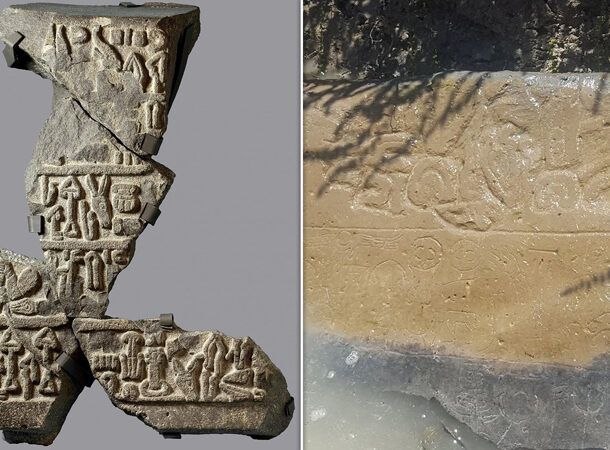 https://www.sciencealert.com/archaeologists-in-turkey-have-discovered-a-mysterious-ancient-kingdom-lost-in-history
https://www.sciencealert.com/archaeologists-in-turkey-have-discovered-a-mysterious-ancient-kingdom-lost-in-history We are all familiar with the legend of King Midas and his golden touch. However, only a few people are aware of the fact that he was a genuine ruler who reigned over the kingdom of Phrygia in Anatolia around 3,000 years ago. A farmer recently notified scientists working at the Türkmen-Karahöyük archaeological site in Turkey about a stone he discovered with strange inscriptions carved on it. A careful examination revealed that the text was written in Luwian and dated from the 8th century BCE.
The writing on the stone revealed the unexpected account of Phrygia’s defeat and subsequent capture of King Midas by an unknown nation headed by a man known as King Hartapu. To this day, little is known about this rival country and its mysterious leader.
The Ancient Egyptians Held Dwarfs In High Esteem
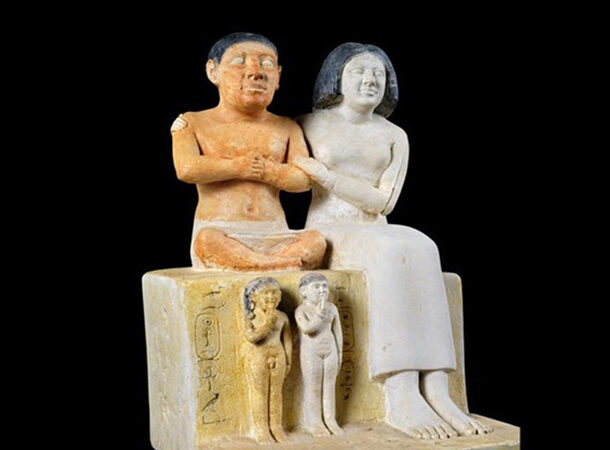 http://news.bbc.co.uk/2/hi/health/4554824.stm
http://news.bbc.co.uk/2/hi/health/4554824.stm The American Journal of Medical Genetics published research in 2005 that revealed that dwarfs were held in very high regard by the ancient Egyptians going as far back as 4500 BCE. The experts arrived at their conclusion after examining artistic evidence and biological remains from beautiful tombs.
They discovered several images of dwarfs on vase paintings, tomb walls, statues, and other artifacts. In the artwork, dwarfs were portrayed as men and women who oversaw precious linens; they were administrators, jewelers, personal attendants, dancers, and entertainers. They also discovered that dwarfs held key positions and were valued enough to own lavish burial sites inside the royal cemetery, telling us that dwarfism was not seen as a physical disability in any way or form in ancient Egypt.
The Highly Civilized Garamantes
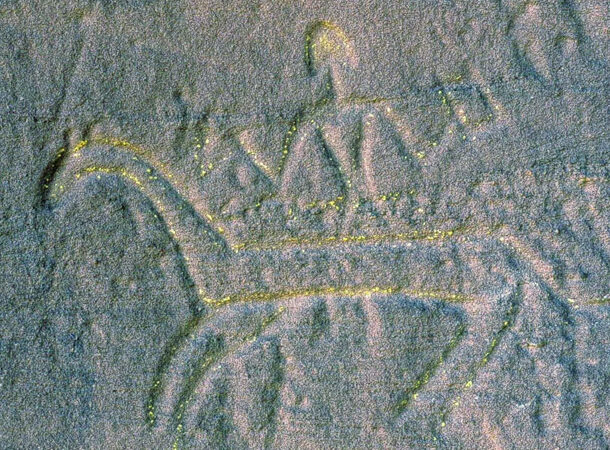 http://www.livescience.com/16916-castles-lost-cities-revealed-libyan-desert.html
http://www.livescience.com/16916-castles-lost-cities-revealed-libyan-desert.html Have you ever heard about the Garamantes? Me neither. The Garamantes were an ancient society that lived in modern-day Libya. Most people familiar with this mysterious civilization are scholars and only know about them due to ancient accounts from the Romans, who referred to them as “uncivilized nomads and agitators at the fringes of the Roman Empire.”
Luckily, we don’t take everything the ancients wrote at face value. Recent studies have revealed that the Garamantes were much more advanced and historically significant than previously believed. In 2011, researchers from the University of Leicester discovered over 100 fortified farms, towns, and villages with castle-like structures built by the Garamantes Civilization in Libya from 1 to 500 CE. Contrary to what the Romans wrote, these structures and settlements demonstrate that the Garamantes were, in fact, highly civilized. Not only did they build impressive structures, but we now also know that they pioneered the establishment of oases and opened up the trans-Saharan trade.
The Sicán Culture Painted With Blood
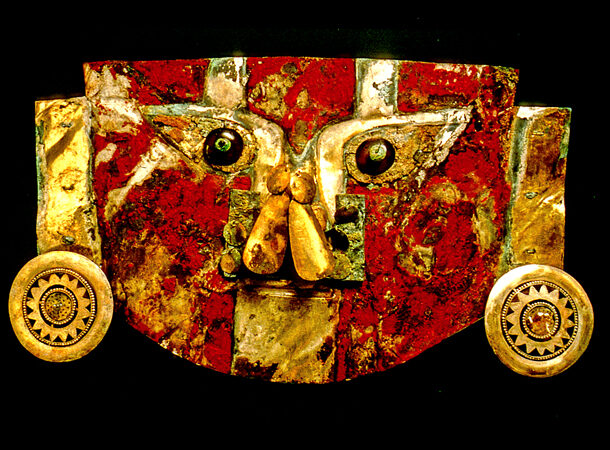 https://www.iflscience.com/chemistry/red-paint-on-preincan-gold-mask-turns-out-to-be-bound-with-human-blood/
https://www.iflscience.com/chemistry/red-paint-on-preincan-gold-mask-turns-out-to-be-bound-with-human-blood/ Before the famous Incan civilization, the Sicán lived in what we now call Peru for over 500 years. In the 1990s, archaeologists uncovered an ancient Sicán tomb over a thousand years old. Inside, they discovered an upside-down skeleton painted red with cinnabar. The man had been buried with two women and two children. But that wasn’t the weird part. Archeologists found the man’s skull had been severed and adorned with a gold mask that had also been painted red with cinnabar.
The fact that the red paint stayed on the mask for such a long time really puzzled researchers. But, in 2021, Oxford University scholars finally tested the paint and discovered that the Sicán created a mixture of human blood and egg whites to serve as a binding agent. Yes, human blood. Scientists now believe that the Sicán associated it with reincarnation.
Our Ancestors Made Weapons With Human Bones
 https://www.smithsonianmag.com/science-nature/ancient-european-hunters-carved-human-bones-weapons-180976570/
https://www.smithsonianmag.com/science-nature/ancient-european-hunters-carved-human-bones-weapons-180976570/ From blood to bones. In ancient times, the land bridge known as Doggerland served as a crucial connection between mainland Europe and Britain. It was during this era that the indigenous people residing in this area crafted weapon points fashioned from bone to be used on arrows, harpoons, and spears.
Recently, researchers made a disturbing discovery when analyzing ten of these weapon points. While eight were made using red deer bones, two were made using human bones. The perplexing question as to why human bone was selected over more durable and readily available materials still remains shrouded in mystery. But not only that – it has also left us with so many questions. Why use human bones when there are more durable and readily available alternatives? Why would you transform your grandpa into an arrow? The questions remain unanswered for now.
The Nazca Civilization Caused Its Own Demise
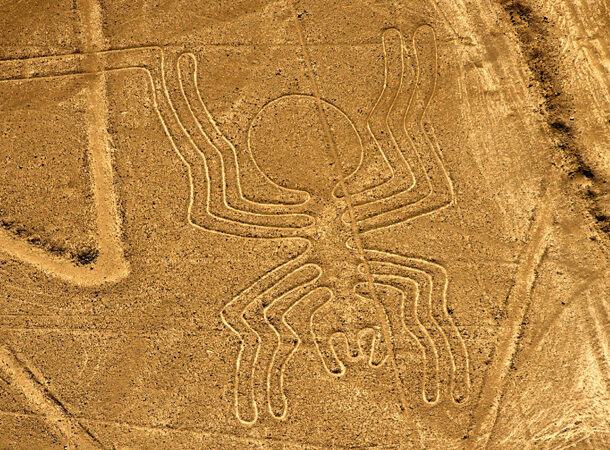 http://www.livescience.com/10591-ancient-civilization-cut-path-demise.html
http://www.livescience.com/10591-ancient-civilization-cut-path-demise.html The Nazca civilization, famous for its massive desert artwork, is an intriguing ancient society that collapsed around 1,500 years ago. While it was initially thought that a large El Nino event was to blame for their demise, new research has revealed that widespread deforestation also played a significant role.
Cambridge University archaeologist David Beresford-Jones discovered that the Nazca people cut down the area’s native Huarango trees to make place for crops like corn and cotton. The deforestation created lasting environmental damage because the trees were critical in supporting the floodplain. Because they were removed, the area became flooded during the major El Nino event, which devastated the Nazca’s irrigation infrastructure and rendered their land unsuitable for agriculture.
The Ancient Chinese Loved To Get High
 https://www.theatlantic.com/science/archive/2019/06/ancient-chinese-artifact-has-traces-cannabis-use/591538/
https://www.theatlantic.com/science/archive/2019/06/ancient-chinese-artifact-has-traces-cannabis-use/591538/ Over 2,500 years ago, the ancient Chinese used cannabis to get high. And not just any old wacky tobacky. During an excavation of Jirzankal Cemetery, researchers discovered that the residue in the ancient pipes contained more THC than the wild cannabis in the area and hypothesized that in ancient times, locals gathered and possibly even domesticated the most potent strands of cannabis for its mind-altering qualities.
Aside from the THC residues, scientists also discovered that many of the remains buried at the site were not indigenous to the region, lending credence to the theory that the Pamir Mountains were once linked to an ancient Silk Road-style trade network and that cannabis was in all likelihood traded along the way. Talk about enlightenment.
The Indus Valley Script Has Yet To Be Deciphered
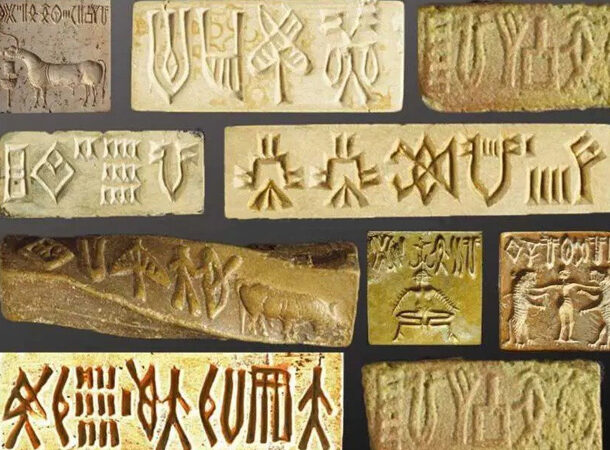 https://www.discovermagazine.com/planet-earth/why-we-still-cant-read-the-writing-of-the-ancient-indus-civilization
https://www.discovermagazine.com/planet-earth/why-we-still-cant-read-the-writing-of-the-ancient-indus-civilization One of the primary reasons we know so little about the Indus Valley Civilization is that their script was never deciphered. Thousands of Indus texts have been uncovered, mostly in Harappa and Mohenjo-Daro, but also in the far-flung corners of their commerce centers throughout the Persian Gulf and Mesopotamia. Most of them are inscribed on simple stone seals of about one square inch (2.5 square centimeters), although inscriptions have also been discovered on clay tablets, metal artifacts, and ceramics.
Since 2004, there has been a $10,000 permanent award for anyone who discovers an Indus text of more than 50 characters. So, if you’re an archeology buff or are just looking for a quick $10k, we only have one question for you. Why aren’t you searching for it yet?
A Mesopotamian Exorcism
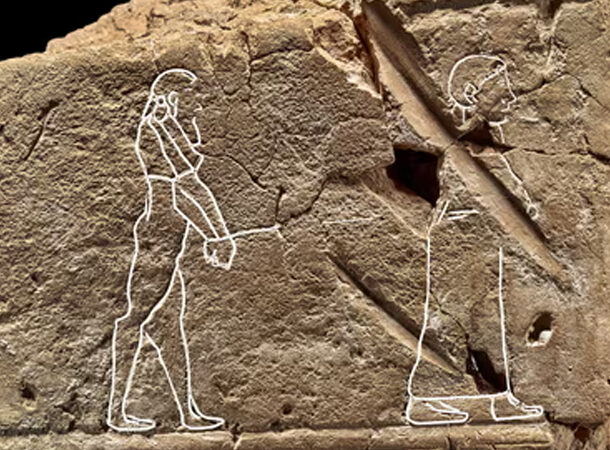 https://www.iflscience.com/editors-blog/oldest-depiction-of-a-ghost-discovered-with-exorcism-instructions-included/
https://www.iflscience.com/editors-blog/oldest-depiction-of-a-ghost-discovered-with-exorcism-instructions-included/ Deep within the confines of the British Museum lies a remarkable artifact that dates back 3,500 years. This particular tablet is thought to showcase the oldest-known depiction of a ghost, along with instructions on how to perform an exorcism. Dr. Irving Finkel discovered the artifact while exploring the museum’s vaults. The image on the tablet depicts a young man who appears to be guiding the ghost of a woman back to the underworld.
Interestingly, the back of the tablet also contains detailed guidelines to assist spirits in crossing over from the realm of the living. It includes instructions for creating two figurines, one male and one female, each adorned with a comb and a bed. As part of the ritual, two beer vessels are prepared, an incantation is recited to the sun deity Shamash, and a warning is given not to never look behind yourself. Creepy.
Ancient People Had Peculiar and Mysterious Skills
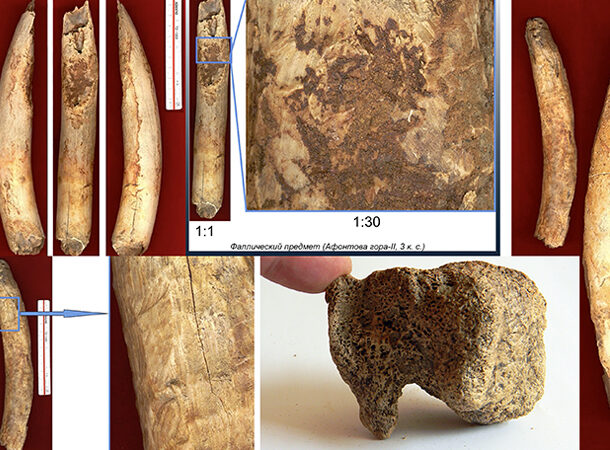 https://siberiantimes.com/other/others/features/prehistoric-people-developed-a-technique-for-turning-woolly-mammoth-ivory-into-a-playdough-like-material/
https://siberiantimes.com/other/others/features/prehistoric-people-developed-a-technique-for-turning-woolly-mammoth-ivory-into-a-playdough-like-material/ We purposefully left this item for number one on today’s list because it simply defies explanation. The skills of ancient people were awe-inspiring, but there was one particularly extraordinary craft. In Siberia, a prehistoric community could transform mammoth tusks into a playdough-like consistency, mold them into animal figurines, and then harden the ivory back into its original state.
When the figurines were discovered in 2000, ivory bars were also found among them. Surprisingly, it was revealed that the playdough technique was not even the softest option available. The bars had been transformed into fluid before being shaped and hardened. The fact that ivory could temporarily become a liquid or clay-like substance remains unexplainable. This skill is even more exceptional because the craftsmen lived 12,000 years ago.



























